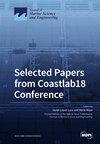Study on the Turning Characteristics and Influencing Factors of the Unmanned Sailboat
IF 2.8
3区 地球科学
Q1 ENGINEERING, MARINE
引用次数: 0
Abstract
Unmanned sailboats can convert wind energy with sails to provide power for navigation, which can independently plan routes and collect data without human intervention. They have received increasing attention in recent years due to their low power consumption and strong self-sustainability. Due to the greater difficulty of manipulation, the unmanned sailboats have a weaker maneuverability than the propeller-driven vessels in the complex and variable marine environment. Typically, the turning motion is evaluated to characterize the maneuverability of a vessel, which has rarely been investigated in the existing research on unmanned sailboats. Therefore, this study builds a motion simulation platform for unmanned sailboats based on the 3 m class Petrel Sail to investigate the turning characteristics. The index of the approximate turning circle is introduced based on the turning motion trajectory, which is used to obtain the effect of rudder angle, wind angle, wind speed, and current speed on the turning performance of the sailboat in ideal hydrostatic conditions and under flow disturbance, respectively. Finally, a harbor pool test is conducted with an unmanned sailboat to verify the analysis results, and the errors in maximum transverse distance and maximum advance distance are in the reasonable range, proving the correctness of the theoretical results. The current study also provides theoretical guidance for subsequent research on sailboat manipulation and maneuverability.无人驾驶帆船的转弯特性及影响因素研究
无人驾驶帆船可以利用风帆转换风能,为航行提供动力,可以在无人干预的情况下独立规划航线和收集数据。由于其耗电量低、自持力强,近年来受到越来越多的关注。由于操纵难度较大,在复杂多变的海洋环境中,无人驾驶帆船的机动性要弱于螺旋桨驱动的船只。通常情况下,通过评估转弯运动来表征船只的机动性,而在现有的无人驾驶帆船研究中,很少对转弯运动进行研究。因此,本研究以 3 米级 Petrel Sail 为基础,建立了无人驾驶帆船运动模拟平台,以研究其转弯特性。根据转弯运动轨迹,引入近似转弯半径指标,分别求出理想静水条件和水流扰动条件下,舵角、风角、风速和流速对帆船转弯性能的影响。最后,用无人驾驶帆船进行港池试验验证分析结果,最大横向距离和最大前进距离的误差均在合理范围内,证明了理论结果的正确性。本次研究也为后续的帆船操纵和机动性研究提供了理论指导。
本文章由计算机程序翻译,如有差异,请以英文原文为准。
求助全文
约1分钟内获得全文
求助全文
来源期刊

Journal of Marine Science and Engineering
Engineering-Ocean Engineering
CiteScore
4.40
自引率
20.70%
发文量
1640
审稿时长
18.09 days
期刊介绍:
Journal of Marine Science and Engineering (JMSE; ISSN 2077-1312) is an international, peer-reviewed open access journal which provides an advanced forum for studies related to marine science and engineering. It publishes reviews, research papers and communications. Our aim is to encourage scientists to publish their experimental and theoretical results in as much detail as possible. There is no restriction on the length of the papers. The full experimental details must be provided so that the results can be reproduced. Electronic files and software regarding the full details of the calculation or experimental procedure, if unable to be published in a normal way, can be deposited as supplementary electronic material.
 求助内容:
求助内容: 应助结果提醒方式:
应助结果提醒方式:


